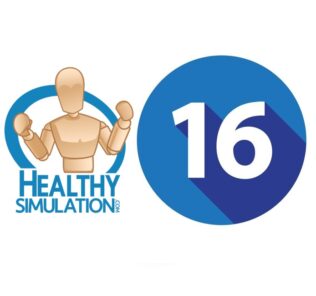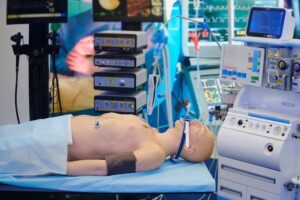Downloadable NCLEX Test Plan Checklists for Nursing Simulation
The National Council of State Boards of Nursing (NCSBN) has developed a licensure examination, the National Council Licensure Examination for Registered Nurses (NCLEX-RN), which is used by member board jurisdictions and most Canadian nursing regulatory bodies, to assist in making licensure decisions. In this article, Dr. Kim Baily, PhD, MSN, RN, CNE, previous Simulation Coordinator for Los Angeles Harbor College and Director of Nursing for El Camino College, shares two Downloadable Test Plan Checklists for Nursing Simulation programs to help evaluate both medical simulation scenarios and their programs.
Although entry into the practice of nursing is regulated by the licensing authorities within each of the National Council member board jurisdictions, each jurisdiction requires candidates for licensure to meet set requirements that include passing an examination that measures the competencies needed to perform safely and effectively as a newly licensed, entry-level RN.
The National Council of State Boards of Nursing (NCSBN) has developed a licensure examination, the National Council Licensure Examination for Registered Nurses (NCLEX-RN), which is used by member board jurisdictions and most Canadian nursing regulatory bodies, to assist in making licensure decisions. The test plan is reviewed and approved by the NCLEX Examination Committee every three years. Multiple resources are used, including the recent practice analysis of registered nurses (RNs), and expert opinions of the NCLEX Examination Committee (NEC), NCSBN content staff, and boards of nursing/regulatory bodies to ensure that the test plan is consistent with nurse practice acts.
Sponsored Content:
Curricula should be reviewed on a regular basis to ensure that all the components of the Test Plan are covered by the courses offered by the program in a systematic way. Learners should also be encouraged to review the Test Plan to ensure that they are studying required material.
The most recent version was published in April 2019. HealthySimulation.com has created two checklists based on the latest version of the NCLEX Test Plan which may be used by programs to identify where content is covered throughout the program and help identify where NCLEX content is included in simulation activities. A short form provides a cross check with the main framework below and a second longer form, provides details of each component of the framework.
The long form could easily be adjusted to use as a checkoff sheet to ensure that all NCLEX material is covered in coursework. Simulation readily lends itself to all areas of the Test Plan. Many existing scenario objectives will most likely match NCLEX content.
Identification of where medical simulation scenario and course objectives match the NCLEX Test Plan should help facilitate program evaluation and accreditation reports.
Sponsored Content:
The Test Plan framework was based on Client Needs and is divided into four categories:
- Safe and Effective Care Environment
- Management of Care 17–23%
- Safety and Infection Control 9–15%
- Health Promotion and Maintenance 6–12%
- Psychosocial Integrity 6–12%
- Physiological Integrity
- Basic Care and Comfort 6–12%
- Pharmacological and Parenteral Therapies 12–18%
- Reduction of Risk Potential 9–15%
- Physiological Adaptation 11–17%
As the use of Simulation in Nursing schools is increasing State Boards of Nursing (BONs) are attempting to set standards for clinical simulation. Indeed, the NCSBN has published guidelines for simulation program and faculty development. Please see future HealthySimulation.com articles where these guidelines will be reviewed. Below is excerpt of key areas covered in the short form (with even more detail in the long form!):
Safe and Effective Care Environment
- Management of Care
- Advanced Directives/Self-Determination/Life Planning Continuity of Care
- Advocacy Establishing Priorities
- Assignment, Delegation, Supervision Ethical Practice
- Case Management Informed Consent
- Client Rights Information Technology
- Collaboration with Interdisciplinary Team Legal Rights and Responsibilities
- Concepts of Management Performance Improvement (QI)
- Confidentiality/Information Security Referrals
- Safety and Infection Control
- Accident/Error/Injury Prevention Reporting of Incident/Event/Irregular Occurrence/Variance
- Emergency Response Plan Safe Use of Equipment
- Ergonomic Principles Security Plan
- Handling Hazardous and Infectious Materials Standard Precautions/Transmission-Based Precautions/Surgical Asepsis
- Home Safety Use of Restraints/Safety Devices
- Health Promotion and Maintenance
- Aging Process High Risk Behaviors
- Ante/Intra/Postpartum and Newborn Care Lifestyle Choices
- Developmental Stages and Transitions Self-Care
- Health Promotion/Disease Prevention Techniques of Physical Assessment
- Health Screening
- Psychosocial Integrity
- Abuse/Neglect Mental Health Concepts
- Behavioral Interventions Religious and Spiritual Influences on Health
- Coping Mechanisms Sensory/Perception Alterations
- Crisis Intervention Stress Management
- Cultural Awareness/Cultural Influences on Health Substance Use and Other Disorders and
- Dependencies
- End-of-Life Care Support Systems
- Family Dynamics Therapeutic Communications
- Grief and Loss Therapeutic Environment
Physiological Integrity
- Basic Care and Comfort
- Assistive Devices Nutrition and Oral Hydration
- Elimination Personal Hygiene
- Mobility/Immobility Rest and Sleep
- Non-Pharmacological Comfort Interventions
- Pharmacological and Parenteral Therapies
- Adverse Effects/Contraindications/Side Effects/Interactions Medication Administration
- Blood and Blood Products Parenteral/Intravenous Therapies
- Central Venous Access Devices Pharmacological Pain Management
- Dosage Calculation Total Parenteral Nutrition (TPN)
- Expected Actions and Outcomes
- Reduction of Risk Potential
- Changes/Abnormalities in Vital Signs Potential for Complications of Diagnostic Tests/Treatments/Procedures
- Diagnostic Tests Potential for Complications from Surgical Procedures and Health Alternations
- Laboratory Values System Specific Assessments
- Potential for Alteration in Body Systems Therapeutic Procedures
- Physiological Adaptation
- Alterations in Body Systems Medical Emergencies
- Fluid and Electrolyte Imbalances Pathophysiology
- Hemodynamics Unexpected Response To Therapies
- Illness Management
Download the HealthySim NCLEX Test Plan For Clinical Simulation Long Form
Download the HealthySim NCLEX Test Plan For Clinical Simulation Short Form
Learn more about NCLEX Test Plans on the NCSBN Website!
Dr. Kim Baily, MSN, PhD, RN, CNE has had a passion for healthcare simulation since she pulled her first sim man out of the closet and into the light in 2002. She has been a full-time educator and director of nursing and was responsible for building and implementing two nursing simulation programs at El Camino College and Pasadena City College in Southern California. Dr. Baily is a member of both INACSL and SSH. She serves as a consultant for emerging clinical simulation programs and has previously chaired Southern California Simulation Collaborative, which supports healthcare professionals working in healthcare simulation in both hospitals and academic institutions throughout Southern California. Dr. Baily has taught a variety of nursing and medical simulation-related courses in a variety of forums, such as on-site simulation in healthcare debriefing workshops and online courses. Since retiring from full time teaching, she has written over 100 healthcare simulation educational articles for HealthySimulation.com while traveling around the country via her RV out of California.
Sponsored Content:




















